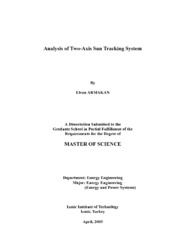Please use this identifier to cite or link to this item:
https://hdl.handle.net/11147/3786Full metadata record
| DC Field | Value | Language |
|---|---|---|
| dc.contributor.advisor | Yardımoğlu, Bülent | en |
| dc.contributor.author | Armakan, Elvan | - |
| dc.date.accessioned | 2014-07-22T13:52:21Z | - |
| dc.date.available | 2014-07-22T13:52:21Z | - |
| dc.date.issued | 2003 | en |
| dc.identifier.uri | http://hdl.handle.net/11147/3786 | - |
| dc.description | Thesis (Master)--Izmir Institute of Technology, Energy Engineering, Izmir, 2003 | en |
| dc.description | Includes bibliographical references (leaves: 64-66) | en |
| dc.description | Text in English; Abstract: Turkish and English | en |
| dc.description | xii, 66 leaves | en |
| dc.description.abstract | In this study, a two-axis sun tracking system with an open loop computer control is analyzed. For this purpose, a gyroscope-like prototype with two degrees of freedom is designed. In order to control the prototype and track the sun all along the day, computer software based on astronomical equations is developed. Beside the software, an electronic circuit ensuring communication layer in between computer and the prototype is designed and manufactured.Software determining the sun position precisely and controlling the prototype is developed utilizing a Visual Basic compiler on a Pentium IV 1600 MHz computer. Input-output signals in between the computer and the electronic circuit is managed through the parallel port (LPT) of the computer. Control of the prototype motors are performed by amplifying the sun position-related computer signals on the electronic circuitry.Critical components of three-dimensional system model created in Computer-Aided Design (CAD) and Computer-Aided Engineering (CAE) software are analyzed from statical aspect. In addition, mathematical model of the system and its stability analysis is generated in Matlab/Simulink software.Last, a fixed-type photovoltaic cell and a two-axis sun tracking photovoltaic cell satisfying a particular tracking sensitivity are theoretically analyzed and compared. A two-axis sun tracking system working to fulfill a specific tracking sensitivity is theoretically seen to provide about 40 % higher energy gain when compared to a fixed system under extraterrestrial solar radiation. | en |
| dc.language.iso | en | en_US |
| dc.publisher | Izmir Institute of Technology | en |
| dc.rights | info:eu-repo/semantics/openAccess | en_US |
| dc.subject.lcc | TJ810. A75 2003 | en |
| dc.subject.lcsh | Solar energy--Mathematical models | en |
| dc.subject.lcsh | Sun trackers | en |
| dc.subject.lcsh | Gyroscopes | en |
| dc.title | Analysis of two-axis sun tracking system | en_US |
| dc.type | Master Thesis | en_US |
| dc.institutionauthor | Armakan, Elvan | - |
| dc.department | Thesis (Master)--İzmir Institute of Technology, Energy Systems Engineering | en_US |
| dc.relation.publicationcategory | Tez | en_US |
| item.languageiso639-1 | en | - |
| item.fulltext | With Fulltext | - |
| item.openairecristype | http://purl.org/coar/resource_type/c_18cf | - |
| item.openairetype | Master Thesis | - |
| item.grantfulltext | open | - |
| item.cerifentitytype | Publications | - |
| Appears in Collections: | Master Degree / Yüksek Lisans Tezleri | |
Files in This Item:
| File | Description | Size | Format | |
|---|---|---|---|---|
| T000260.pdf | MasterThesis | 2.46 MB | Adobe PDF |  View/Open |
CORE Recommender
Page view(s)
158
checked on Jul 22, 2024
Download(s)
148
checked on Jul 22, 2024
Google ScholarTM
Check
Items in GCRIS Repository are protected by copyright, with all rights reserved, unless otherwise indicated.